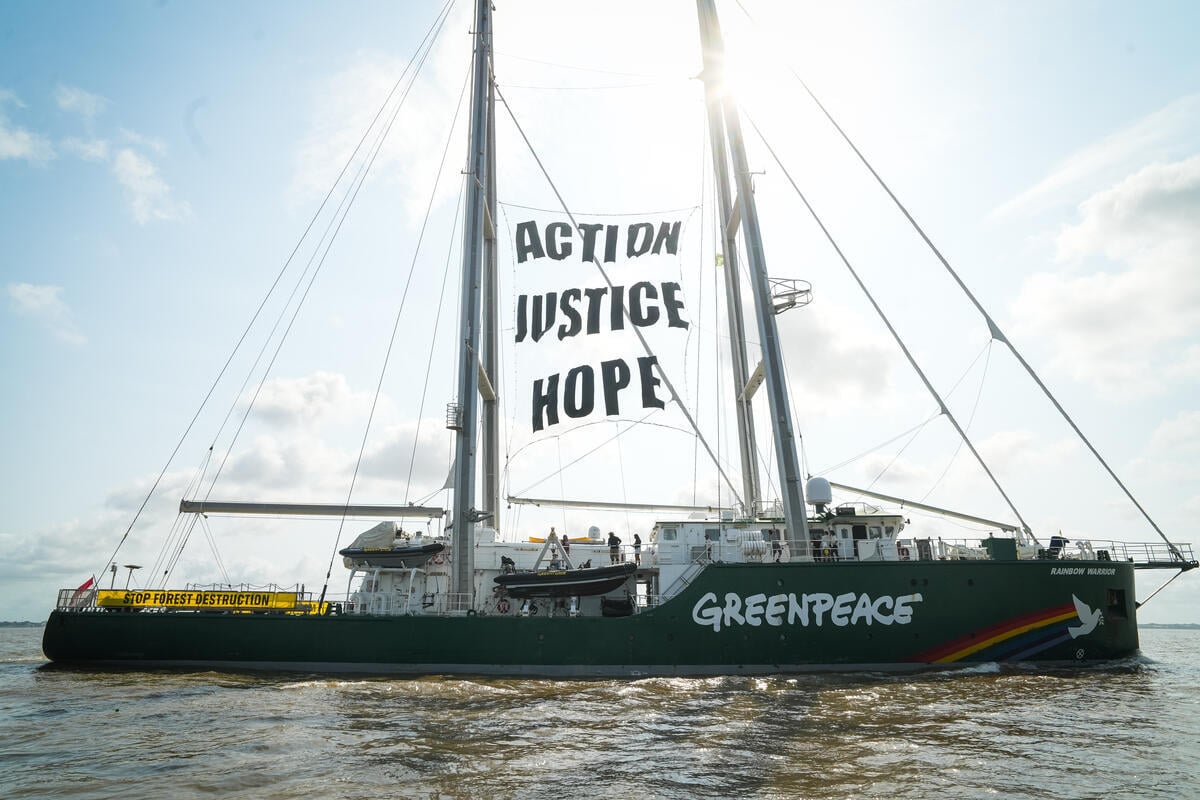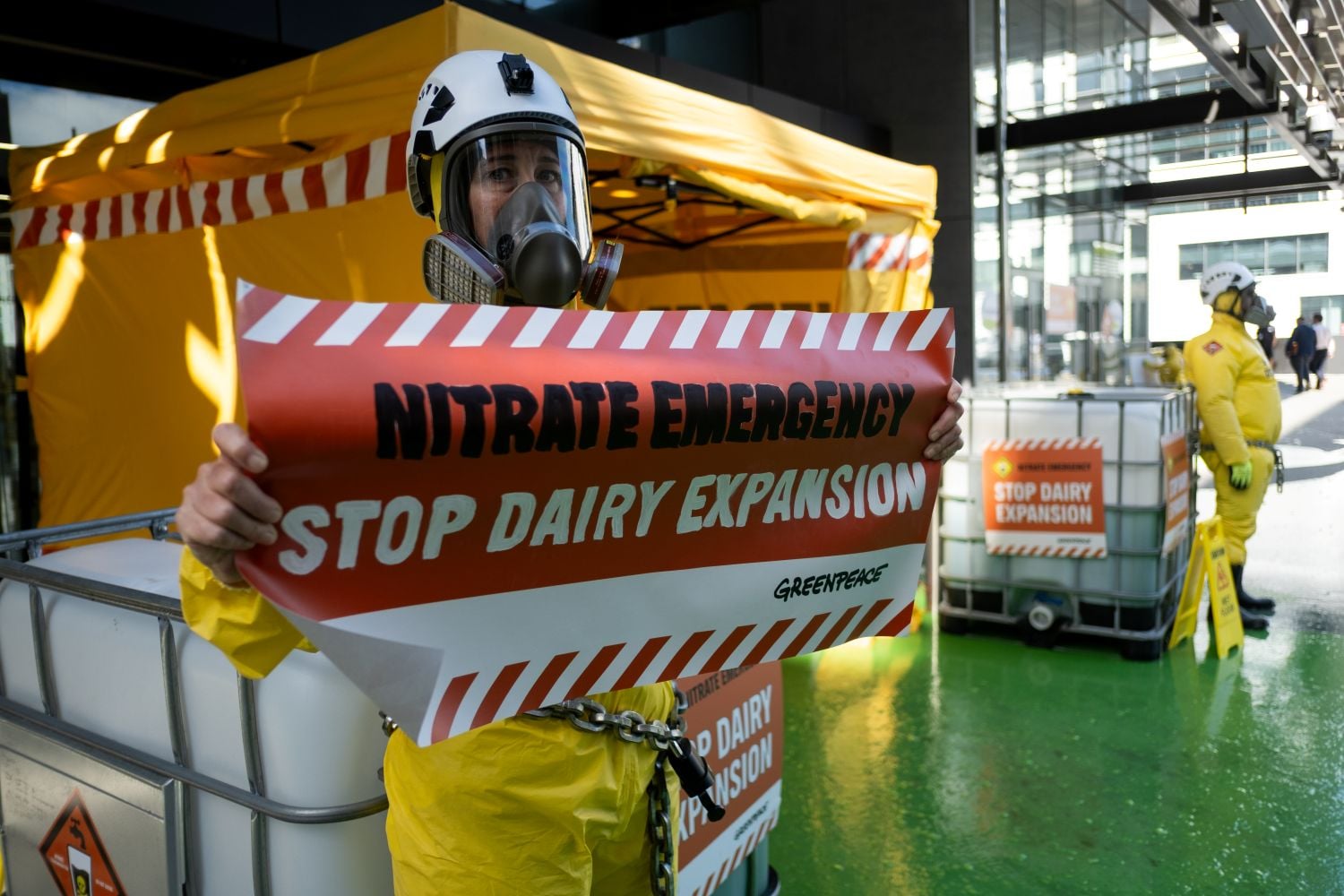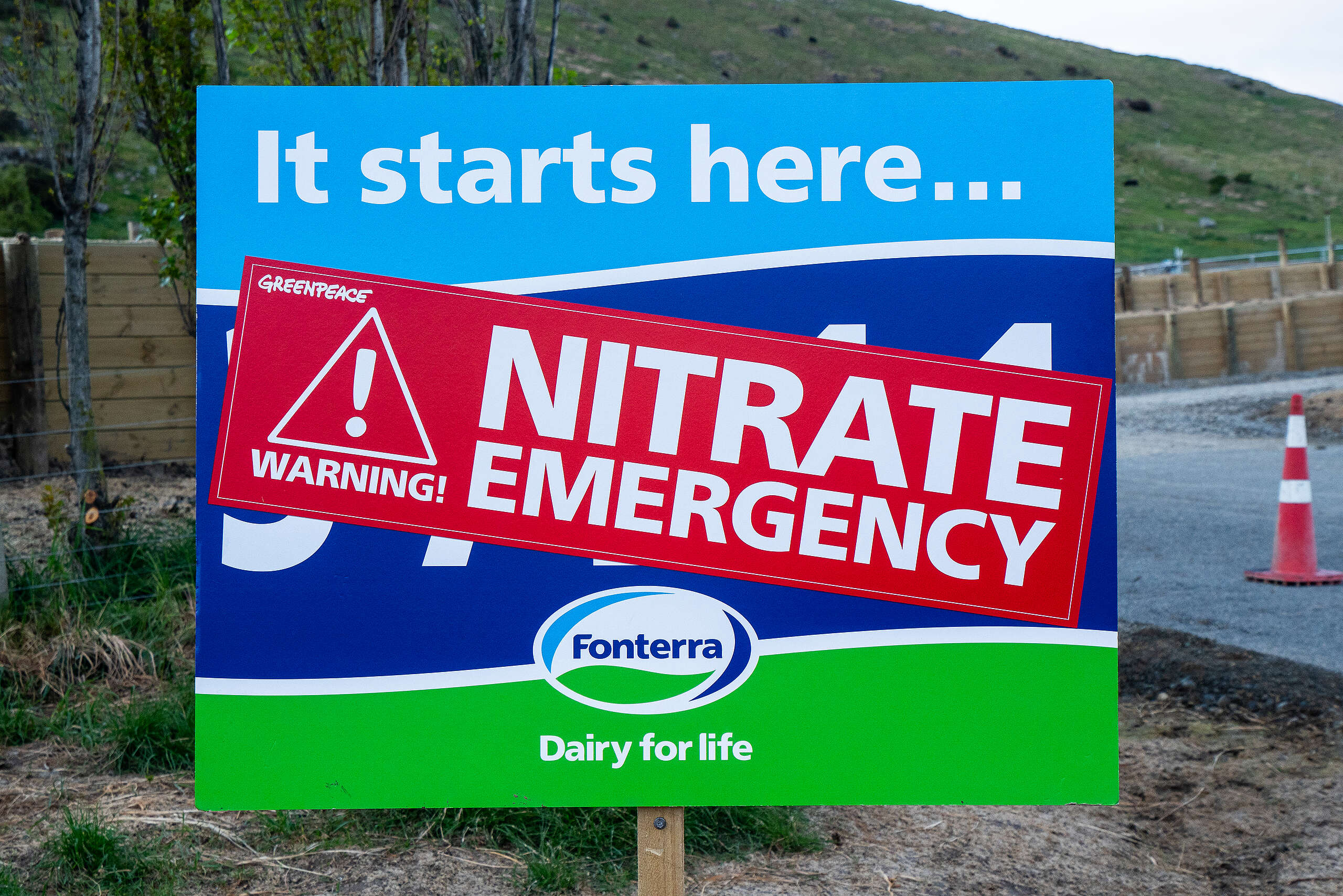Greenpeace has launched a groundbreaking new interactive ‘know your nitrate’ map indicating nitrate contamination levels of drinking water across New Zealand, warning of health risks from the higher nitrate concentrations.
- Greenpeace’s ‘Know Your Nitrate’ map shows nitrate contamination levels in drinking water across New Zealand
- High levels of nitrates in water can cause health problems, like bowel cancer & pregnancy complications
- 800,000 New Zealanders are at risk of exposure to hazardous levels of nitrate in their drinking water
Table of contents
What is the Know Your Nitrate map?
Everybody has a right to safe drinking water, no matter who they are or where they live. No family should have to wonder if the water from their kitchen tap could be making them sick. That’s why rising nitrate contamination – particularly in rural areas of New Zealand – is concerning, and that’s why we have collated the data to present the Know Your Nitrate Map.
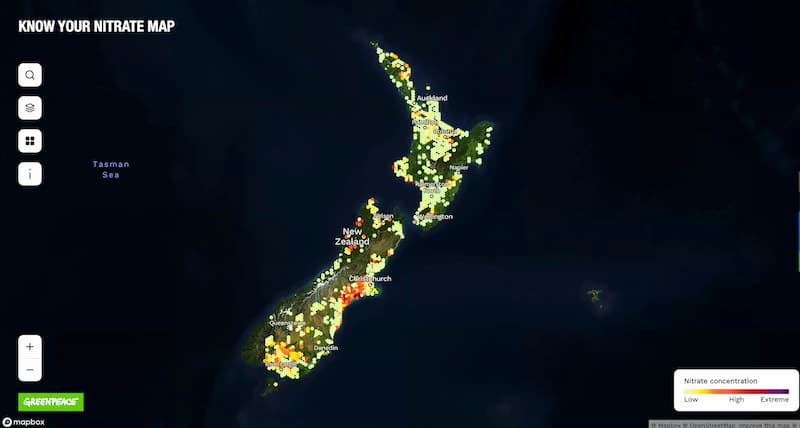
Over the last two years, Greenpeace has offered free water testing of bore water for rural areas. We’ve conducted community testing events in numerous areas where we’ve spent time talking with affected communities, and we’ve offered a mail-in water testing service, and people have sent in their water samples for testing.
Through that testing programme, we’ve collected the biggest data set of its kind, showing the areas in New Zealand with the most and least contaminated drinking water. The Know Your Nitrate Map allows you to zoom in on your neighbourhood and see what the nitrate levels are near you and what they may be at your place.
Scientists warn that 800,000 New Zealanders are at risk of exposure to hazardous levels of nitrate. Up to 100 cases of bowel cancer and 40 deaths every year could be attributable to nitrate contamination of drinking water. Families in rural areas impacted by intensive dairy and high synthetic nitrogen fertiliser use are more likely to be exposed.
Nitrate has no odour, taste or colour and is the most pervasive water contaminant in New Zealand. The Know Your Nitrate map is designed to inform and warn the public of the potential health risks of nitrate in drinking water. It can give you some idea of what contamination levels might be in your area, but you should get it tested to be sure.
If you have any concerns about your water, you should get it tested.
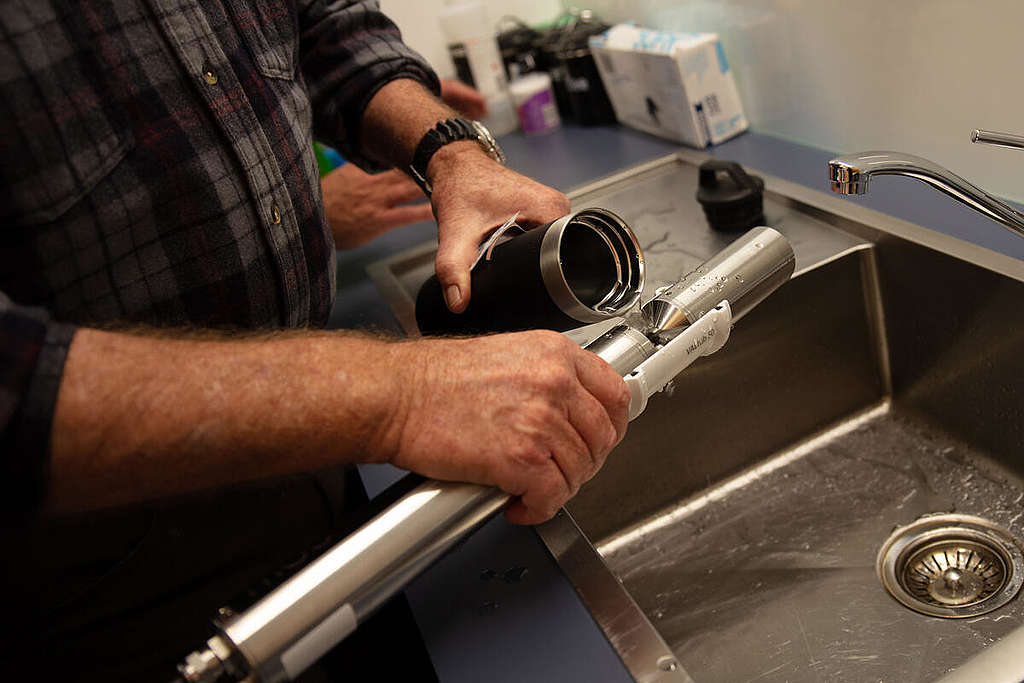
What is nitrate contamination?
Nitrate is the most pervasive groundwater contaminant in New Zealand, and nitrate contamination of drinking water is a significant hazard to human health. The higher the nitrate, the greater the potential risk.
Many households on self-supply bore and well water are unaware of their potential nitrate exposure because nitrate contamination testing of self-supply bore water is not done systematically in New Zealand.
A number of public water supplies in rural areas, such as Southland and Canterbury, also have nitrate elevations that risk public health.
Causes of nitrate contamination in the Know Your Nitrate map
Cow urine and synthetic nitrogen fertiliser used predominantly by the dairy industry in great quantities are the leading sources of nitrate contamination.
Increased fertiliser use and intensification of dairying over the past 30 years are the primary cause of worsening nitrate contamination.
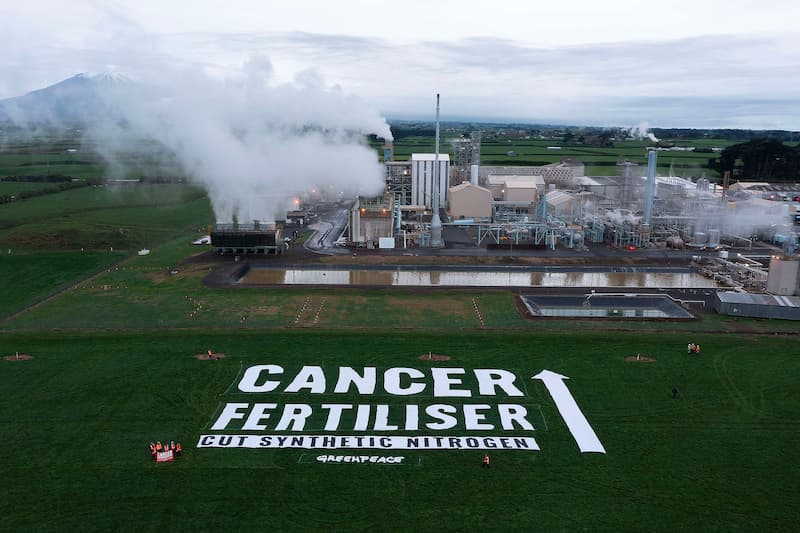
If you’re drinking water from a bore or a groundwater supply and it shows elevated nitrate concentrations, the odds are that it is caused by diffuse pollution from intensive agricultural activity in your area. Some reticulated town supplies in Southland and Canterbury are also showing elevated nitrate.
Synthetic nitrogen fertiliser and intensive dairying are the largest causes of increased nitrate contamination in our water. The parts of New Zealand with high dairy cow numbers are also the regional hotspots for high nitrate concentrations in drinking water, including Canterbury, Waikato and Southland. We are also seeing high nitrate contamination in some market gardening areas, such as Richmond in the Tasman District.
Synthetic nitrogen fertiliser is added to pasture to accelerate grass growth so excessive numbers of cows can be kept on the land. Most of the nitrogen that cows ingest passes through them and is excreted as urine and dung, which leeches nitrate into groundwater. The indirect leaching of nitrate from dairy cow urine patches is the largest source of nitrate contamination. The dairy industry is the biggest user of synthetic nitrogen fertiliser. In New Zealand, we have seen a nearly sevenfold increase in synthetic nitrogen fertiliser use over the past 30 years, a doubling of the dairy herd, and a worsening of nitrate concentrations in many groundwater wells.
This is one of the reasons Greenpeace continues to call for stronger regulation of the dairy sector to reduce cow numbers and cut the usage of synthetic nitrogen fertiliser for growing grass.
What are the health risks of nitrate contamination shown on the map?
Drinking water contaminated with nitrate over time can have a cumulative effect that should not be underestimated.
For many years, we have known that high concentrations of nitrate in drinking water used for mixing infant formula is linked to blue baby syndrome – where the nitrate deprives the baby’s blood of oxygen. This can be a life-threatening condition for babies.
In New Zealand, our drinking water standards have a maximum allowable value (MAV) for nitrate (NO3-N) of 11.3 mg/L. This limit was set by the World Health Organisation in the 1950s as the limit necessary to avoid blue baby syndrome.
New Zealand public health physician Professor Michael Baker says the limit is “hopelessly out of date” because it does not account for chronic illnesses like cancer.
There is also growing evidence of potential for increased colorectal cancer risk from nitrate at levels as low as 1 mg/L. So, to be safe, we should ensure that everyone has access to drinking water that has nitrate under 1 mg/L.
The New Zealand College of Public Health Medicine and Public Health Association has stated that, “Excessive levels of nitrate pollution, from dairy farms, in drinking water is a direct threat to human health such as being linked to miscarriages in pregnant women. Long-term consumption of nitrate in drinking water is associated with the risk of several cancers such as thyroid, colorectal, non-Hodgkin’s lymphoma, stomach, bladder, breast, and ovarian.”
What can we do about nitrate contamination?
To ensure healthy water for all, we need to farm differently, with far fewer cows and no synthetic nitrogen fertiliser to grow grass.
By moving to more plant-based regenerative and organic farming, we can provide healthy nutrition from the land without harming our water supplies.
Use the map to check out your area, share with friends, and get your water tested if you have any concerns at all.
If you have more questions about the science, how to get your water tested, how often to test it or what to do if you have drinking water with high nitrate levels, head over to our more detailed nitrate contamination information page.
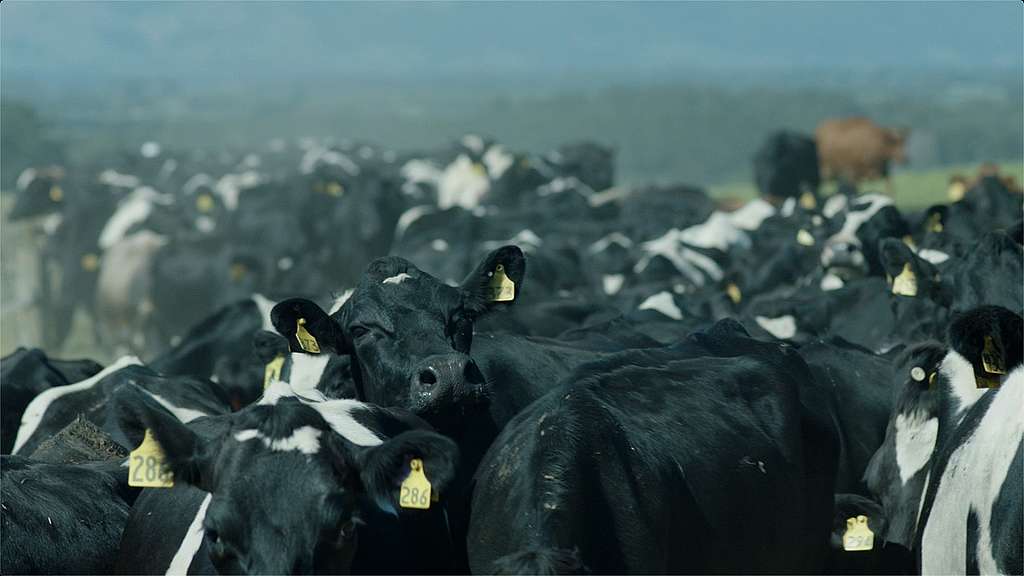
Sign on now to call on the New Zealand Govt to ban chemical nitrogen fertiliser.
Take Action
